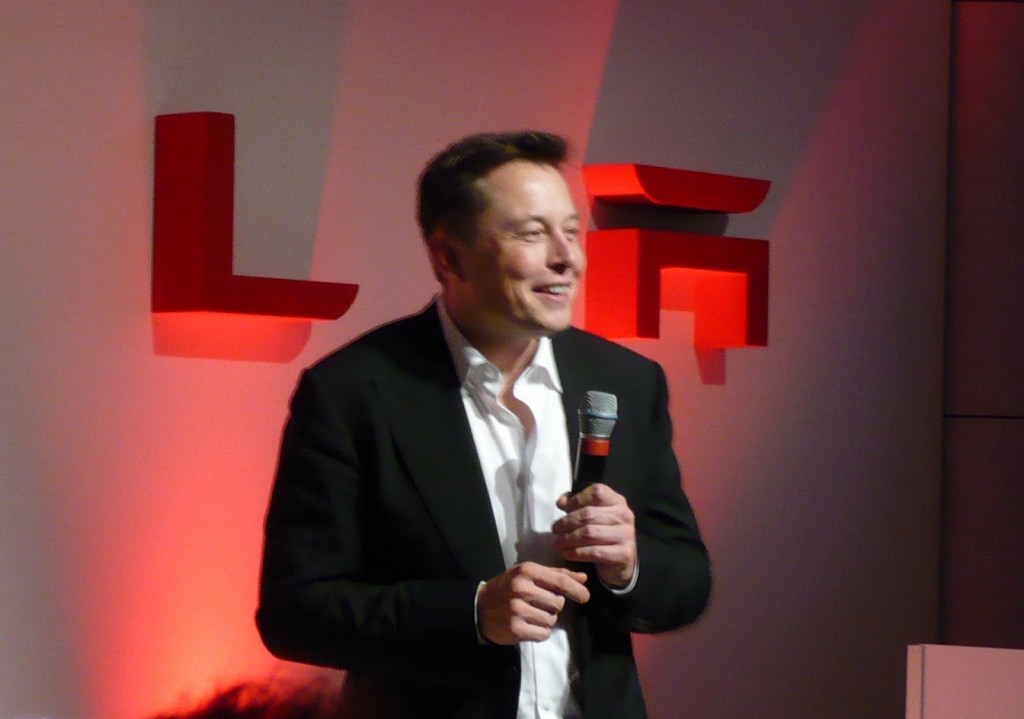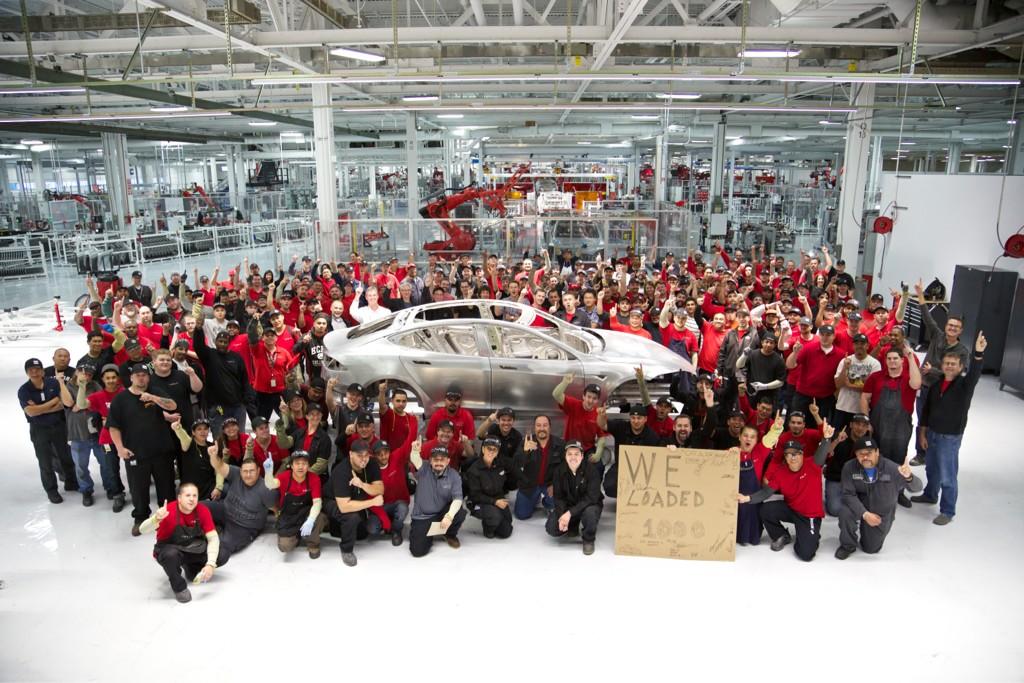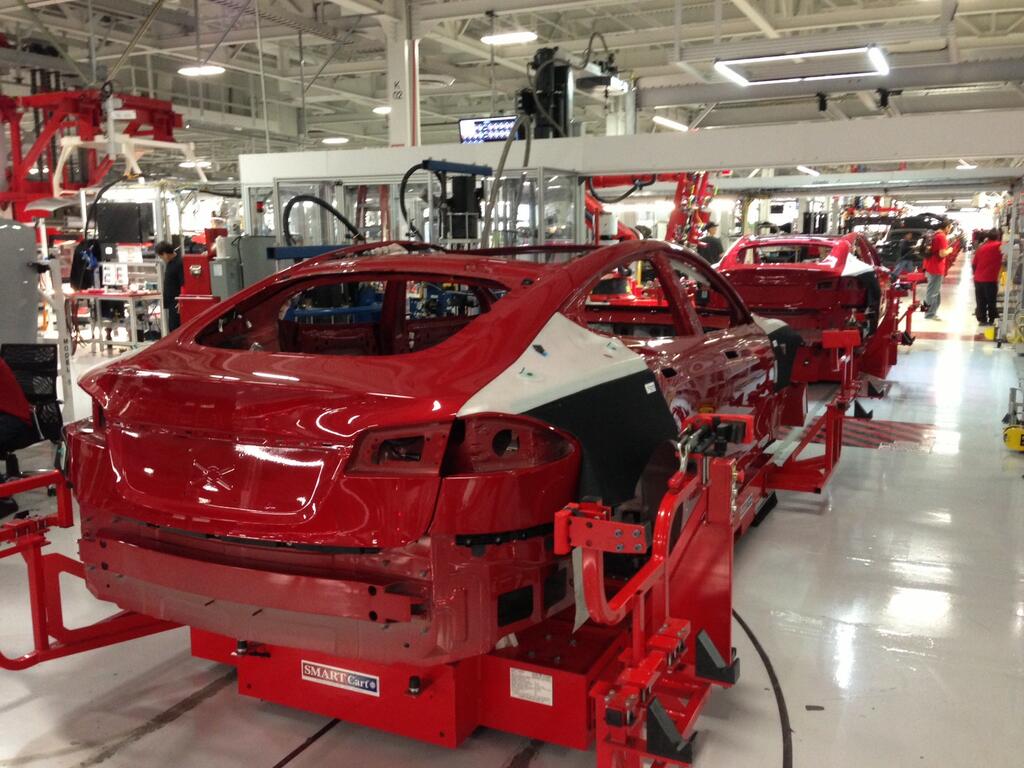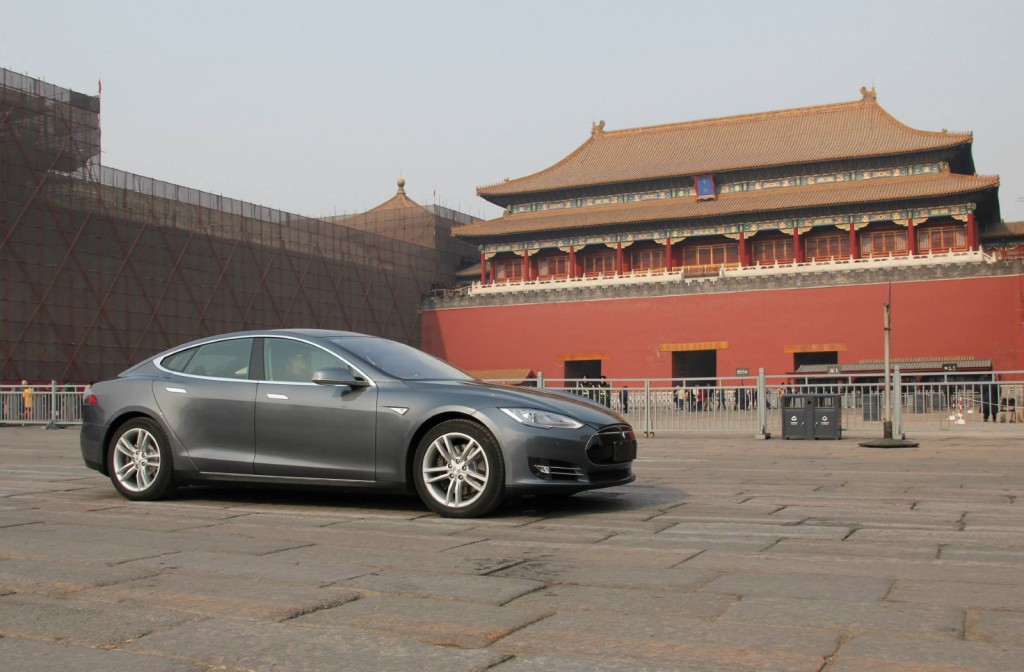
Tesla Motors CEO Elon Musk at Motor Trend 'Car of the Year' ceremony in New York City, Nov 2012
On February 11, electric-car maker Tesla Motors will release its 2014 earnings and hold a conference call for financial analysts to discuss them.
If recent patterns hold, the company won't disclose a number of the important operating metrics that reveal how well it's doing.
In fact, over the last two years, Tesla has quietly stopped providing several pieces of data it routinely reported when it launched the Model S electric luxury sedan.
DON'T MISS: Tesla Model S P85D 'Insane' Mode: NSFW Video Shows How Insane It Really Is
An article two weeks ago on the investing site SeekingAlpha notes that "Tesla is disclosing less and less information about its operations."
The article, titled "The Incredible Shrinking Tesla Disclosure," also points out that the company recently stopped providing Model S production data, a crucial indicator of its current level of operations.
![2014 Tesla Model S P85D, road test, Dec 2014 [photo: David Noland] 2014 Tesla Model S P85D, road test, Dec 2014 [photo: David Noland]](https://images.hgmsites.net/lrg/2014-tesla-model-s-p85d-road-test-dec-2014-photo-david-noland_100494834_l.jpg)
2014 Tesla Model S P85D, road test, Dec 2014 [photo: David Noland]
Tesla is hardly alone in highlighting only information that reflects best on its operations, especially if those operations may not be going according to previously announced plans.
But at some point, investors and analysts may start to ask why the company won't say how many cars it sold in each country, how many orders it's received for its cars--or even how many cars it's built.
Lack of transparency could be a cause for nervousness, among not only those in the finance industry but among Model S owners and Tesla advocates alike.
"Every time Tesla stops disclosing a piece of information," the article concludes, "it happens because disclosing that piece of information could lead to negative interpretations of the data."
ALSO SEE: How Many Tesla Model S Electric Cars Have Been Built So Far?
And that appears to be at the crux of the matter.
CEO Elon Musk doesn't trust anyone--financial analysts, journalists, or the company's legions of supporters--to understand the context and background behind Tesla's operating metrics.

Tesla Motors CEO Elon Musk at Tesla Store opening in Westfield Mall, London, Oct 2013
So the company simply won't quantify what it's done, settling mostly for sweeping generalizations and a focus on its future plans.
Its financial reports provide the data in dollars on its operations, of course, as legally required by the Securities and Exchange Commission.
But the high-level summaries--how many cars were built, or sold--have lately gone missing.
Those monthly sales
It all started in mid-2012, after Tesla began delivering Model S production cars, including the first 1,000 known as the "Signature Series," to its very earliest deposit holders.
![First production 2012 Tesla Model S [detail from photo by evancharlesmoore on instagram] First production 2012 Tesla Model S [detail from photo by evancharlesmoore on instagram]](https://images.hgmsites.net/lrg/first-production-2012-tesla-model-s-detail-from-photo-by-evancharlesmoore-on-instagram_100392479_l.jpg)
First production 2012 Tesla Model S [detail from photo by evancharlesmoore on instagram]
The first Model S went to Silicon Valley venture capitalist and board chair Steve Jurvetson--and within months, a Tesla Model S was the hot new car to have in Silicon Valley.
Tesla declined to give its monthly sales that year, a not altogether unreasonable decision as production slowly increased and the company faced parts shortages from suppliers who had tooled up for only a fraction of the necessary production.
MORE: Why Is Tesla Scared To Release Its Electric-Car Sales Data? (Jun 2012)
Two and a half years later, Tesla still declines to provide monthly sales--in the U.S. or any other market--as every other automaker does, including low-volume specialty makers with only a fraction of Tesla's volume.
(Think Ferrari, for instance, which limits itself to producing 7,000 cars each year.)
![2012 Tesla Model S display screen [Photo: Flickr user jurvetson] 2012 Tesla Model S display screen [Photo: Flickr user jurvetson]](https://images.hgmsites.net/lrg/2012-tesla-model-s-display-screen-photo-flickr-user-jurvetson_100393720_l.jpg)
2012 Tesla Model S display screen [Photo: Flickr user jurvetson]
Reservations long gone
Meanwhile, the company's practice of revealing reservations--which it had done in quarterly reports from the time of its initial public offering in June 2010 through the end of 2012--ended with first-quarter results in 2013.
The company said in its report only that "quarter-end reservation data is no longer a meaningful metric, nor is it comparable to prior quarters," due to a change in the reservation process.
So an indicator of demand was no longer being discussed.
Instead, Musk habitually reiterates during many of the quarterly analyst calls that Tesla is constrained not by demand, but by its production capacity.
That assertion, however, can no longer be backed up by publicly available data.

1,000th body for 2012 Tesla Model S on display at Tesla Motors factory, Fremont, CA, Oct 28, 2012
Sales could still be approximated by the company's quarterly reports of U.S. deliveries, which it reported for the U.S. during and then for Europe as that market came online in 2013.
But any breakout of deliveries by market vanished after its fourth-quarter report for 2013. Only the total global delivery number was provided.
Model S production numbers
Still, if delivery and reservation data are diffuse, at least Tesla reported each quarter how many cars it had actually built during that three-month period.
As the SeekingAlpha article documents, that practice too ended with its third-quarter 2014 results.

2012 Tesla Model S beta vehicle, Fremont, CA, October 2011
Rather than providing the number of cars it built during the third quarter (8,763 for the second quarter), the company said only that production had been affected by a factory shutdown for retooling that had taken longer than expected. No data.
Tesla also declined to project the next quarter's production, as it had previously done.
Based on observed serial numbers, Green Car Reports estimated earlier this month that total Model S production had crossed 70,000 cars.
A cogent analysis by owner Ben Reser suggests the total is lower than that, because not all serial numbers are assigned to cars produced sequentially.
All in all, the SeekingAlpha article concludes:
There is a pattern emerging regarding Tesla's disclosure of information. In this pattern, every time a piece of information that's being disclosed turns negative, Tesla immediately ceases disclosing it.
It happened with orders/reservations/cancellations, then with the geographic breakdown of deliveries and now with production data.
It remains to be seen what Tesla will choose to disclose in its fourth-quarter and 2014 year-end financial results.

Tesla Motors CEO Elon Musk at Motor Trend 'Car of the Year' ceremony in New York City, Nov 2012
Perhaps Tesla will report annual deliveries, possibly even breaking that total down by region.
Right now, all we know is that the company said six months ago it expected to deliver 33,000 cars in 2014, down slightly from its initial projection of 35,000.
Response: Musk comments
Green Car Reports asked Tesla for a response to the assertions in the SeekingAlpha article, in particular on the practice of eliminating data that had previously been available.
Rather than responding directly, Tesla global communications director Khobi Brooklyn provided a transcript of CEO Elon Musk's comments on sales reporting during the third-quarter earnings call:
Part of the reason why we don't release the monthly deliveries number is just because it varies quite a lot by region and then the media tends to read all sorts of nonsense into deliveries.
We'll have like 1,000 cars reach a country one month and none the next month and then people -- or like 100 the next month trickle in or something because those were the numbers that were registered in one month versus the next and people say Tesla sales dropped by a factor of 10.
They assume deliveries are proxy for demand, which is not the case.
Red 2013 Tesla Model S cars roll down the production line (Photo: @elonmusk on Twitter)
It is the case for other car companies, but in our case, it really needs be parsed into orders and deliveries.
Orders is not a true measure of demand. It is just a measure of that's the amount of stuff we need to do to meet our production and delivery number.
So if we released orders, people would try to read the tea leaves and say demand for Tesla is growing or dropping.
No, we're just not pulling the levers that we could pull because there's no point in trying to amplify demand substantially beyond our ability to produce it and deliver it. That would just make people upset.
In other words, "Reporters aren't smart enough to put our monthly sales, which vary, in the proper context."
Further: "Nor can Tesla trust any of those parties to understand orders--which aren't actually a proxy for demand, because we can't build enough cars to satisfy all the demand that's out there."
Musk appears to leave the question of why exactly orders do not reflect demand unanswered.

2014 Tesla Model S in China
U.S. sales lower due to China, Europe
Brooklyn also provided some further background on how Tesla views deliveries and demand:
Production remains the dynamic factor, not demand. Tesla is delivering Model S not just in North America and Europe, but China, Japan, and Australia. Many cars are being shipped overseas and are therefore not reflected in the US registration numbers.
As a result of the allocation of production and delivery among these expanding markets, we are at a lower volume of US registrations versus last year.
We are aiming for 33,000 delivered Model S in 2014 and registrations will be reflected accordingly in the respective markets for all cars delivered.
Tesla does not consider a car sold until it is delivered into the owner’s hands. Custom-ordered Model S that are in transit to customers are considered unsold during that time.
Tesla Motors CEO Elon Musk at Motor Trend 'Car of the Year' ceremony in New York City, Nov 2012
While the majority of owners go through the custom order process, Tesla has a certain amount of Model S with the most popular options available for those whose schedules lean toward a more immediate purchase than our standard custom-built process which takes 4-6 weeks in the United States.
Tesla did not respond to a follow-up query from Green Car Reports as to whether it was saying that "deliveries" was a different number than "sales."
In reporting car sales, "deliveries" and "sales" to retail customers refer to the same statistic; both include not only sales but also leases.

Tesla Model S P85D, 2015 Detroit Auto Show
But Tesla's definition of sales in the third paragraph of Brooklyn's response appears to be exactly the same as any other carmaker's.
Current challenges
Its Model S P85D continues to receive rave reviews, and a number of owners of older Model S versions have suddenly decided the P85D is their new must-have vehicle.
But it's undeniable that Tesla Motors faces a handful of challenges as it enters 2015.
It had to restructure its operations in China, where its top executive recently departed amidst reports that sales were lower than anticipated and retail buyers were not stepping up as expected.
The longer-than-expected production shutdown last summer likely deprived the company of more than 1,000 Model S vehicles it could have delivered, leading to pressure on income.
And the company still hasn't shown the final production version of its multiply-delayed Model X crossover utility vehicle, now scheduled to start deliveries in the third quarter of this year.
In part, that may be because Tesla needs to keep attention on the Model S so that electric sedan keeps selling until Model X deliveries can begin.
The P85D was a smart way to do that--as the millions of views on a video of riders reacting to its astounding acceleration attests.
![Tesla Model S P85D 'Insane' mode acceleration [frame capture from DragTimes video] Tesla Model S P85D 'Insane' mode acceleration [frame capture from DragTimes video]](https://images.hgmsites.net/lrg/tesla-model-s-p85d-insane-mode-acceleration-frame-capture-from-dragtimes-video_100498651_l.jpg)
Tesla Model S P85D 'Insane' mode acceleration [frame capture from DragTimes video]
Think different
Over the years, Tesla has shown that it can repeatedly confound expectations and achieve goals that many viewed as next to impossible.
Sneering at the company's design capabilities largely stopped after it displayed a Model S body shell at the Detroit Auto Show in January 2011.
That body-in-white put the industry on notice that the company actually knew how to design passenger cars.
The high quality of the Model S, the rollout of a nationwide Supercharger DC fast-charging network, and annual sales of high-priced electric sedans by a company that didn't exist a decade ago--all have been impressive accomplishments that many said couldn't be done.
And it may be that Tesla can continue to report only the operating data it chooses.
It may be that its CEO can continue to reveal crucial future products simply by tweeting them.

Photo of Tesla Model S battery swapping versus 'fastest gas pump in LA' tweeted by Elon Musk
And it may be that Model S sales will continue to rise in many markets, enabled by its recently-expanded annual production capacity, which Tesla says will reach 100,000 cars by the end of this year.
If so, Tesla's lack of transparency may not matter.
But the company is likely watching market sentiment and its stock price carefully.
In the end, companies that are less than transparent are sometimes punished by the market.
Tesla scheduled the date for the release of its 2014 financial results today; they will be issued on Wednesday, February 11, after the U.S. markets close. A conference call for analysts will be held at 5:30 pm Eastern that same day.
_______________________________________________













